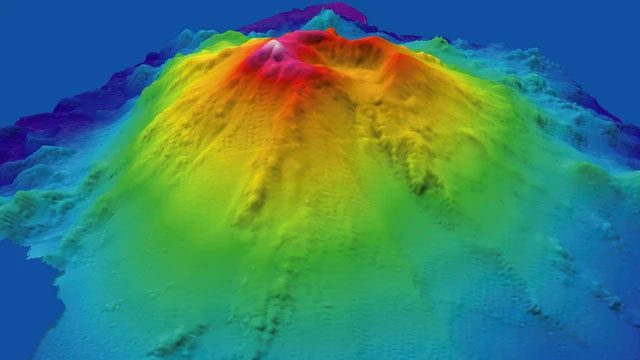A massive object riding on a tectonic plate is gradually descending into the Earth’s crust, causing severe earthquakes in Japan.
This frightening object is a submarine volcano, situated near the intersection of three tectonic plates, according to Live Science.
Named Daiichi-Kashima, this dormant submarine volcano is located at the edge of the Pacific tectonic plate, just 40 km off the eastern coast of Japan.
It is a “subduction zone”, where the Pacific Plate to the east and the Philippine Plate to the south are gradually sliding beneath the Okhotsk Plate to the north.

The object causing earthquakes off the coast of Japan is a submarine volcano slowly descending into the Earth’s crust – (Photo: NOAA).
This subduction activity began approximately 150,000 to 250,000 years ago, causing this underground object to progressively move deeper into the Earth’s crust, according to Associate Professor Euseo Choi from the Earthquake Information and Research Center at the University of Memphis, one of the co-authors of the study.
Dr. Sungho Lee, the lead author and also from the University of Memphis, stated that even though the submarine volcano is nearly 50 km below the Earth’s surface, it still has the potential to trigger earthquakes.
It has been identified as the cause of many significant earthquakes that Japan has experienced over the past four decades, including those with magnitudes ranging from 7 to 7.8 on the Mercalli scale.
On this earthquake scale, magnitudes of 7-7.8 indicate major earthquakes with severe damage. The highest level on the Mercalli scale is 8 and above, which denotes earthquakes strong enough to completely obliterate communities near the epicenter.
The earthquakes attributed to the Daiichi-Kashima submarine volcano include the 2011 Tōhoku earthquake and tsunami, a disaster that devastated the Fukushima nuclear power plant.
This disaster registered 7.8 on the Mercalli scale, 9 on the Japan Meteorological Agency’s scale, and 9.1 on the Richter scale, making it the strongest earthquake in Japan’s history.
When one tectonic plate slides or subducts beneath another, the scattered faults on its surface rub against the underside of the upper plate. However, a 2008 study suggested that this friction was not sufficient to cause the tremors that Japan has faced.
But new data suggests otherwise.
Seismic information collected from the ocean floor near Japan indicates that submarine volcanoes encounter significant resistance as they ride on a subducting plate, sometimes even becoming stuck.
The friction that the volcanic section experiences is substantial. Stress accumulates at the leading edge of the volcano over time, and when the volcanic section becomes trapped, surrounding sections continue to move.
This accumulation cannot continue indefinitely. Eventually, the stress will become large enough to pull the trapped object down.
The sudden release of tension creates an explosive force that shakes the overlapping tectonic plates, resulting in a series of new earthquakes.
According to Dr. Lee, this volcano may also be responsible for even older earthquakes, including the earthquake that triggered the tsunami disaster in Japan in 1677.
This will continue as the tectonic plates keep moving.
Tectonic plates can be understood simply as the pieces of the Earth’s crust; they are constantly moving, sliding over one another, carrying oceanic and continental plates along. This is why the land on Earth has repeatedly coalesced into supercontinents and then broken apart.



















































